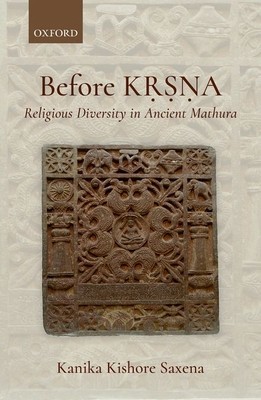
- We will send in 10–14 business days.
- Author: Kanika Kishore Saxena
- Publisher: Oxford University Press, USA
- ISBN-10: 0190127902
- ISBN-13: 9780190127909
- Format: 14.5 x 23.9 x 3.1 cm, hardcover
- Language: English
- SAVE -10% with code: EXTRA
Reviews
Description
Mathura is most famous for its association with Vasudeva-Krsna, an important deity of the Hindu pantheon. In ancient times, however, this site contributed towards the production of exquisite pieces of sculpture, inscriptions, and terracottas associated with Buddhism, Jainism, and the Naga and
Yaksa traditions as well. The literature and art inspired by these traditions make the religious landscape of Mathura a fascinating subject of study. Before Krsna is one such work that entails an epigraphic analysis of Mathura from the early historical till the early medieval period. It examines the
content of inscriptions from Mathura, correlates it with other archaeological and literary sources, and assesses the available data in the context of the social, political, and economic processes underway in the Indian subcontinent at that time. This monograph not only provides the reader a taste of
Mathura's religious diversity and plurality over time, but is also relevant for understanding the history of specific religious traditions and the threads of interaction between them.
EXTRA 10 % discount with code: EXTRA
The promotion ends in 17d.15:23:11
The discount code is valid when purchasing from 10 €. Discounts do not stack.
- Author: Kanika Kishore Saxena
- Publisher: Oxford University Press, USA
- ISBN-10: 0190127902
- ISBN-13: 9780190127909
- Format: 14.5 x 23.9 x 3.1 cm, hardcover
- Language: English English
Mathura is most famous for its association with Vasudeva-Krsna, an important deity of the Hindu pantheon. In ancient times, however, this site contributed towards the production of exquisite pieces of sculpture, inscriptions, and terracottas associated with Buddhism, Jainism, and the Naga and
Yaksa traditions as well. The literature and art inspired by these traditions make the religious landscape of Mathura a fascinating subject of study. Before Krsna is one such work that entails an epigraphic analysis of Mathura from the early historical till the early medieval period. It examines the
content of inscriptions from Mathura, correlates it with other archaeological and literary sources, and assesses the available data in the context of the social, political, and economic processes underway in the Indian subcontinent at that time. This monograph not only provides the reader a taste of
Mathura's religious diversity and plurality over time, but is also relevant for understanding the history of specific religious traditions and the threads of interaction between them.


Reviews